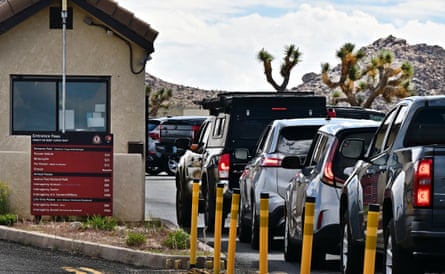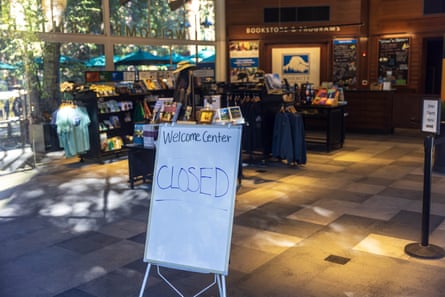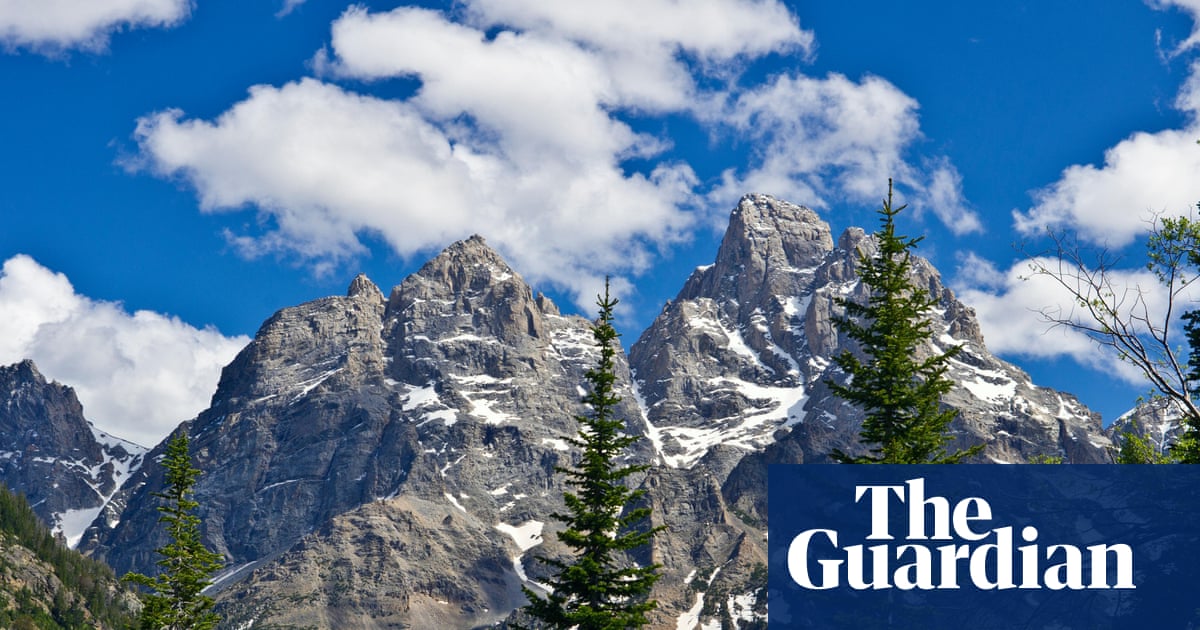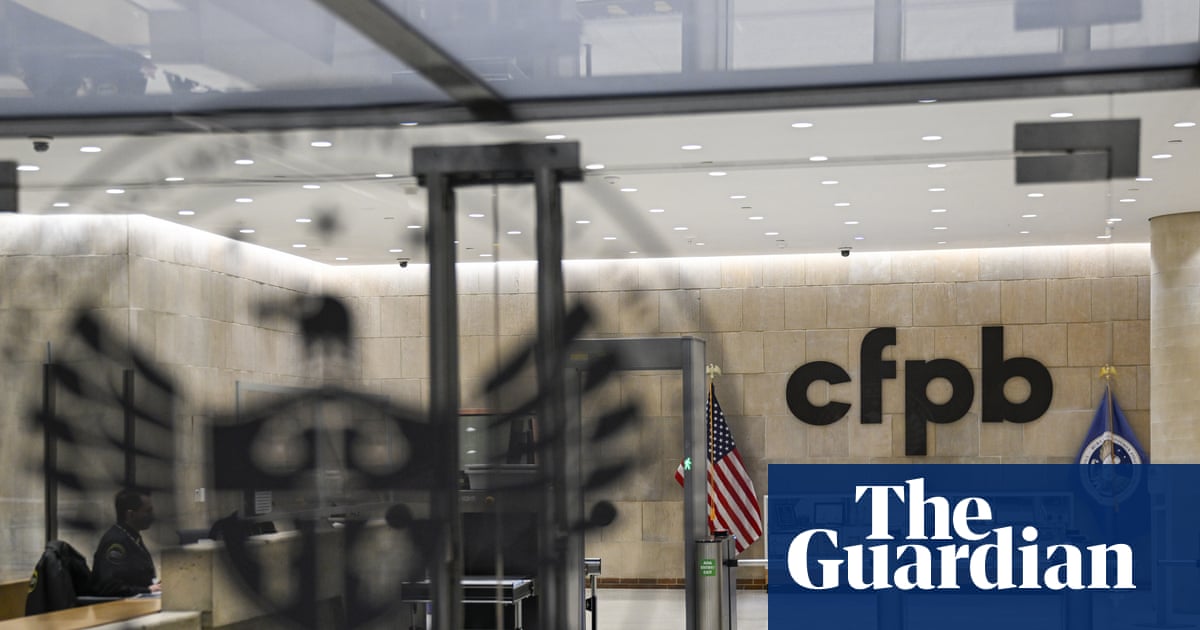Cars and RVs surged into Yosemite national park throughout the weekend, as visitors from around the world came to enjoy the crisp autumn weather, undeterred by a lack of park services and the absence of rangers.
National parks have largely been kept open through the lapse in US federal funding that has left workers furloughed and resources for the parks system more scarce than usual. But as the US government shutdown enters its third week and legislators warn that their impasse could linger even longer than the one in Trump’s first term – which currently holds the record at 35 days – concerns are mounting over how the nation’s treasured public lands will fare.
Even with winter weather setting in along the Sierra, which will create more dangerous conditions, visitors continued to pour into the park, filling campgrounds and parking lots over the long weekend.
Already, there have been widespread reports of illegal activity in Yosemite. People have been spotted Base jumping off high granite peaks, swimming in reservoirs where it is prohibited, camping and parking in unauthorized areas and climbing Half Dome’s cables without permits.
One of the limited park employees seen on duty during the holiday weekend, who spoke under the condition of anonymity because they were not allowed to comment publicly, said it had been chaotic. “Then again, when is it not?” he added sardonically.
Relying on funds pulled from entrance fees collected before the shutdown – a budget kept separate from federal appropriations – Yosemite has retained maintenance and emergency services to ensure bathrooms, trash and campgrounds are kept up and emergency operations continue. A concessionaire, Yosemite Hospitality, has also continued to operate.

Previous use of these fees, collected under the Federal Lands Recreation Enhancement Act, to support park operations during shutdowns was found to be a violation of the law by a 2019 Government Accountability Office analysis.
And, even with trash cans emptied and toilets cleaned, the loss of key staff could be keenly felt.
“It felt like you showed up to school and none of the teachers were there,” said Mark Rose, the Sierra Nevada & clean air senior program manager for the National Parks Conservation Association, after spending a portion of last week at Yosemite. “You could tell the janitors had been there the night before and maybe there were hall monitors there – but we are missing this big piece.”
Workers who provide other essential functions such as trail maintenance, those who offer support and monitor visitation at entrance gates, and staff responsible for ongoing conservation or maintenance projects have not been able to continue working.
On Saturday, as droves of vehicles rolled through entrances where fees typically would have been collected and guidance given, they were met with signs on the empty booths that read: “During this lapse in appropriations parks will remain as accessible as possible. We are doing our best to take care of your parks at this time, but some amenities and services may not be available.”
In one booth, the sign was accompanied by a second: a hand-drawn bluebird with the familiar scrawl of a child pleading: “Put park rangers first.”
Dangerous, damaging and illegal activity was a chief concern among advocates when the administration opted to keep parks accessible without adequate staffing. Before the start of this shutdown, national park leaders and advocates had pushed the Trump administration not to repeat its previous policies of 2018-19, when the parks were kept open and unstaffed, leading to widespread destruction.

“National parks don’t run themselves. It is hard-working National Park Service employees that keep them safe, clean and accessible,” 40 former superintendents said in a letter issued to Doug Burgum, the interior secretary, in the week leading up to the lapse. “If sufficient staff aren’t there, visitors shouldn’t be either.”
Irreversible damage was done at popular parks, including Joshua Tree in California, following a month-long shutdown in Donald Trump’s first term, when his administration demanded parks be kept open while funding was paused and workers were furloughed.
Without supervision, visitors left behind trails of wreckage. Prehistoric petroglyphs were vandalized at Big Bend national park. Joshua trees, some more than a century old, were chopped down at Joshua Tree national park, as trash and toilets overflowed. Tire tracks crushed sensitive plants and desert habitats from illegal off-roading vehicles in Death Valley. There were widespread reports of wildlife poaching, search-and-rescue crews were quickly overwhelmed with calls, and visitor centers were broken into.
“This is exactly what we warned about,” Emily Thompson, executive director of the Coalition to Protect America’s National Parks, said in a statement issued following the reports of how visitors were behaving in Yosemite. “This shutdown is making an already bad situation at national parks and public lands far worse. And the longer this goes, the worse it is going to get. The situation is dangerous and reckless for our parks, public lands, and the visitors who love them.”
Burgum called the Yosemite incidents “misinformation” in a post on the social media platform X on Tuesday, and falsely claimed the park was “fully staffed”.
“Yosemite has a full team working to uphold public safety and preserve the integrity of the park,” he said, before blaming Democrats for the shutdown. “Unauthorized camping, squatting, and illegal activities like BASE jumping are being addressed with firm, appropriate law enforcement action.”
According to a recent National Park Service contingency plan created to guide parks during the shutdown, more than 9,200 employees were furloughed system-wide, reducing NPS staff by roughly 64%. Only workers deemed necessary to protect “life and property”, were set to remain on duty.
Even before the shutdown began, sharp reductions in staffing that came as part of the Trump administration’s plans to shrink the federal government left gaps in an NPS workforce already stretched thin. According to Rose of the National Parks Conservation Association, the long-term strain has only been exacerbated by the shutdown as advocates grow exceedingly concerned that more cuts could be coming.
Close to $1bn in funding cuts have been proposed by the administration, and Rose said there were fears that the administration may argue operations were successful during the shutdown as a way to validate their calls for a smaller workforce. With toilets clean and law enforcement on patrol in popular places like Yosemite, visitor experience has been prioritized while other important NPS responsibilities, including conservation, science and education, remain on the chopping block.
“This is a skeleton crew and we have been seeing this from the beginning,” Rose said. “But you can only keep up the facade for so long before major cracks start showing.”

 German (DE)
German (DE)  English (US)
English (US)  Spanish (ES)
Spanish (ES)  French (FR)
French (FR)  Hindi (IN)
Hindi (IN)  Italian (IT)
Italian (IT)  Russian (RU)
Russian (RU)  3 weeks ago
3 weeks ago
























Comments